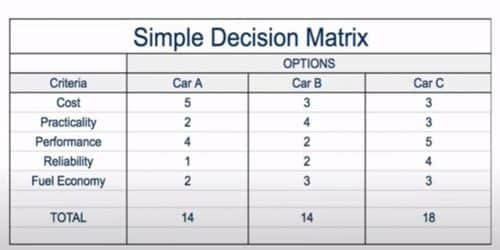When using a decision matrix, you can look at a set of options and decide how important they are. When making a big or complicated decision at work that affects a lot of people, these are very helpful. This article discusses how a decision matrix work, its template, examples, advantages, and disadvantages. It also talks about the 3 types of decision-making in the decision matrix.
What Is a Decision Matrix and Why Is It Used
A decision matrix can help you narrow down your choices and make the right choice when you have more than one good option. This tool will be very helpful if you need to narrow down your options and weigh different factors before making a decision.
A decision matrix is a good way to evaluate and rank a list of possible choices. The group decides on a set of criteria, gives each one a certain amount of weight, and then evaluates each possible course of action.
How Does Decision Matrix Work?
In the decision matrix work, using their approaches, attributes are defined, weighted, and their correct sums are found. These sums are then used to rank the importance of design choices. It’s important to remember that in reality, qualities are given numerical weights based on a ranking system that has already been established.
Depending on the situation, attributes can be either design goals (to be increased or decreased) or constraint functions (to be kept within certain limits). Attributes can be either design criteria or decision criteria, but they are the same thing either way. A decision matrix is a grid with rows and columns that can be used to rank options based on a number of factors.
Before you can use Decision Matrix Analysis, you have to make a table with your possible decisions as rows and the relevant criteria as columns. To get an overall score for each option, you must first assign a weight to each score based on how important the corresponding component is, and then score each option/factor combination.
Use a decision matrix work to:
- To compare several options that are similar.
- Each possible thing on a list must be crossed off.
- Before making a final decision, you need to think about a lot of different things.
- You should not let your feelings get in the way of making this decision.
Why Is a Decision Matrix Useful?
The following are examples of the decision matrix of how they will work or be useful below;
#1. Objectivity
It’s tempting to rely on your own ideas or thoughts when you have to make a decision, but doing so distorts your thinking and often leads to decisions that aren’t the best. A choice matrix can help you look at your choices without being influenced by your own preferences.
#2. Clarity
A choice matrix can put all the important information in one place, which can make even the hardest decisions easier to understand. So, it’s not as hard to think of how many things might be connected to each other.
#3. Efficiency
With the help of a well-designed choice matrix, you can make better decisions in less time because it forces you to weigh all of your options in a systematic way.
Decision Matrix Examples
Decision matrices are helpful for making any kind of business decision that requires comparing and contrasting possible outcomes. It’s not always true that these decisions have to be bad for the company. You can also use this framework to make a simple choice quickly and with little thought.
In one of the examples, imagine that you are deciding on a new wardrobe in a decision matrix. Think about things like cost, value, and time when making your choice. You could also try on clothes from other brands.
Part of the examples of a decision matrix could also include the different kinds of furniture you need for your home or office. In this case, you would want to put quality, price, efficiency, and durability at the top of your list.
On the left side of the table would be the criteria, and across the top would be the choices. Under each criterion, each option would get a score between 1 and 7, with 7 being the best.
Once you’ve scored all the options, it’s easy to find the best one by looking for the row with the highest score.
What Are the 3 Types of Decision-Making?
To better understand how decisions are made, it’s helpful to first classify the different ways decisions can be made. So, the kinds or examples of the decision matrix depend on what happens and who is affected by it. Here are just a few:
- When it comes to business, decisions can have big effects on the company or group in question.
- Individual agency refers to the decisions we make that shape who we are and the relationships we form. This is for decisions that affect a person’s whole life.
- Making good decisions about what to buy can come down to personal taste or good business sense. Both of these things are part of the consumer decision-making process. In this situation, the customer (the “entity”) can be a person or a representative of an organization.
Other Types of Decision-Making Include:
There are many different kinds of decisions, such as those that are made by a computer program and those that aren’t. There are also strategic decisions, policy decisions, group decisions, important decisions, minor decisions, and so on.
Decision Matrix Advantages and Disadvantages
The decision matrix helps organizations in making their choices, this part of the article talks about the advantages and disadvantages
Here are some advantages of using the decision matrix, while its disadvantages are below:
- Even though the decision matrix can be a very helpful tool for designers, it’s important to remember that nothing beats common sense and good judgment when it comes to making final decisions about projects.
- Tools like the decision matrix only work if rating elements are assigned objectively and weighting factors are calculated so that they show the relative importance of different design goals.
- The goal of the method is to help people make good decisions, not to tell them what to do. But the decision matrix shouldn’t be the only thing you use to make a final decision.
- A choice matrix is helpful because it forces us to think carefully about each possible course of action. There is a lot of uncertainty and subjectivity in these factors, which makes it possible to come to the wrong conclusion about which option is better.
- As the design goes on, a good designer will keep asking questions and looking for more evidence to support their choices.
- The main benefit of the decision matrix is that it makes people think critically about their own choices, which helps them avoid bias.
- Using this method, even the hardest decisions will be easy to make.
- Using a decision matrix, you can put things in order of importance, make arguments, and find solutions to problems to back up your decisions.
Disadvantages of Decision Matrix
Here are some of the disadvantages when using a decision matrix, while the advantages are above:
- The choice matrix method is very bad because it doesn’t take uncertainty into account.
- Putting weights on rating elements, etc., also requires a lot of judgment.
- Since the alternatives to the criteria are chosen at random, it is impossible to know if they are all there. Most likely, not enough requirements have been met.
- Some less important factors may also hurt the quality of the final choice if they are included. Even when weighting is taken into account, scoring systems tend to make all standards the same.
- Last but not least, you don’t have any hard data to back up the weights you give to estimates. The choice matrix gives the impression of being scientific, even though it doesn’t give any numbers.
Decision Matrix Template
A decision matrix template is a good way to help a group come to a fair option about something important. As a quantitative method, it looks at how well possible choices match up to a set of criteria that has already been set.
If you can’t choose between a few good options, a decision matrix template might be just what you need.
What Should a Template for a Decision Matrix Have?
The following is what should be in the template for a decision matrix below;
- Options.
- Criteria.
- Weight.
- Score.
What Are 4 Other Names a Decision Matrix Can Be Called?
There are as follows;
Decision matrices go by many names, such as the decision grid, Pugh matrix, problem selection matrix, selection matrix, criteria-based matrix, problem matrix, solution matrix, opportunity analysis, and criteria rating form. A decision matrix can be used to rate and rank a set of possible choices.
How Do You Create a Simple Decision Matrix?
Here’s what you need to do;
- Make a list of the things you’ll use to judge this situation.
- Start a conversation to make the set of rules even better.
- Think about how important each criterion is and give it a weight that reflects its importance.
- Make a grid in the shape of an L.
- Compare your criteria with the answers that might work.
- To compare each choice, you should multiply the rating by the weight.
What Are the Seven Steps in the Decision-Making Matrix?
In the choice-making matrix below, there are seven steps:
- First, one must figure out what choice needs to be made.
- Phase 2: Compile all pertinent data.
- The third step is to think of possible other ways to do things.
- Step 4: Think about how strong the evidence is.
- Step 5: Choose an option that will work.
- Sixth, put what you’ve learned to use.
- Seventh, think about how your choice will affect things in the future (both good and bad)
Is the Decision Matrix Qualitative or Quantitative?
The six thinking hats are a qualitative way to make decisions. The choice matrix is a quantitative way to make decisions by rating ideas based on certain criteria.
Depending on the task at hand and the type of analysis needed, one may choose either a quantitative approach (like a decision matrix) or a qualitative approach (such as the “six thinking hats”). No one is better or worse than anyone else when it comes to making decisions.
How Do You Make a Decision Matrix Sheet?
Here is the following choice-making matrix to help you;
- Make a copy of the example spreadsheet first.
- Second, explain what kind of choice you have.
- Third, type in the values or criteria that will help you decide.
- Think about these things and put them in order of importance.
- The fifth step is to write down all of the possible answers.
- Sixth, rate each possible solution on each of the criteria.
Conclusion
In our daily lives, we have to make many decisions. It really isn’t simple to figure out how to proceed. Once you understand how useful they are, they are surprisingly easy to make. A decision matrix, which is a table that shows all of the possible outcomes and how important each one is, is the best way to decide what to do.
DECISION MATRIX FAQs
In project management, what does a decision matrix mean?
Decision matrices are rows and columns of values that let you visually compare solutions by weighting variables. It’s a tool for thoroughly assessing and choosing the best alternative.
What are the seven components of decision-making?
- Find the choice.
- It’s important to collect all the data that is applicable.
- Recognize the available options.
- Think carefully about the evidence.
- Pick one of these options.
- Don’t sit on your hands.
- Think this choice and its results through.
What are the 5 Cs of making a good choice?
- Considering.
- Consulting.
- Committing.
- Communicating.
- Checking.
Related Articles
- Ansoff Matrix Explained: Practical Examples, Theory, & Strategy
- Project Quality Management Planning Guide (Tools & Software)
- Growth Strategy: 5 Proven Frameworks for any Business with Examples
- What is Project Risk Management? Steps in Creating a Risk Assessment Plan
- Resource Management: Definition, Importance, and Planning






